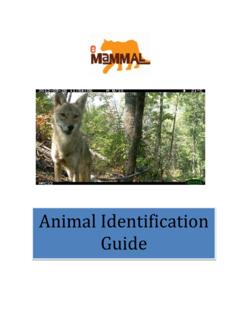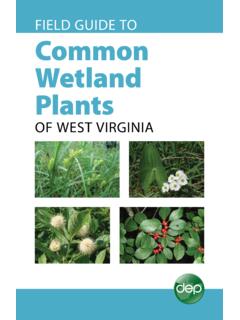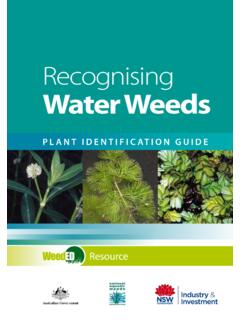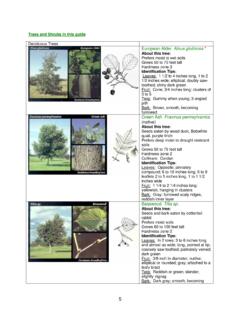Transcription of Pocket Guide to Beach Birds of California
1 A project of PRBO Conservation SciencePocket Guide toBeach Birds of CaliforniaPRBO Conservation Science (PRBO) is dedicated to conserving Birds , other wildlife and ecosystems through innovative scientific research and outreach. Pocket Guide toBeach Birds of CaliforniaLishka Arata and Melissa PitkinPRBO Conservation ScienceCopyright 2009 byPRBO Conservation Science3820 Cypress Drive #11 Petaluma, California UsHelp support PRBO s mission to conserve Birds and their ecosystms through research and outreach. You can join online at receive additional copies of this Guide , please call PRBO Conservation Science (PRBO) at (707) 781-2555 x 354. For more information about PRBO s efforts to understand and protect Pacific Coast beaches and ecosystem conser-vation projects throughout the West visit Give us your feedback at California Coastal Commission s Whale Tail License Plate Grants Program provided the lead grant to develop this Guide .
2 The California Coastal Commission works to protect, conserve, restore, and enhance environmental and human-based resources of the California coast and ocean for environmentally sustainable and prudent use by current and future generations. PRBO biologists Gary Page, Catherine Hickey, Ryan DiGaudio, Rich Stallcup, Dave Shuford, Kriss Neuman, and Dave Dixon provided valuable comments on the content in this Guide . Layout design and production by Claire Peaslee (PRBO).Thanks to the following photographers for donating images:Michael Mike L. Baird ( ); Len Blumin; Lyann Comrack; Ryan DiGaudio; Jenny Erbes; Tom Grey ( ); Ron LeValley ( ); Stuart Mackay; Martin Meyers; David C.
3 Ohlson; Steve Smith. Cover photos: front (Snowy Plover), Jenny Erbes; back (Brown Pelican), Tom Grey; title page (Long-billed Curlew), Mike following partners provided funding for this Guide : California Coastal Commission Whale Tail License Plate Grants Program USFWS Arcata Office USDA Forest Service San Francisco Bay Joint Venture on 100% recycled paper, 50% post-consumer waste, processed chlorine-free are HabitatBeaches of the western United States are important to people and wildlife. They can be sandy or rocky and are found along coastlines, lagoons, estuaries, and sand spits. A popular recreation destination for people, beaches also provide important habitat for wildlife species.
4 Many of California s imperiled and endemic plant and animal species depend on coastal estuaries and beaches. Millions of waterbirds use coastal ecosystems for breeding, migrating and wintering habitat. On the Pacific coast of the United States, oceanfront development, exotic plant species, heavy recreational use, and expanding predator populations threaten coastal Birds , especially the endangered Western Snowy Plover and California Least Tern. The Beach dune ecosystem is degraded to the point that it no longer sustains a viable breeding population of Snowy Plovers or Least Terns without ongoing human intervention. This Guide aims to provide information on how people can share our coasts with Birds and other to Use this GuideThis Guide was written for people interested in learning about the most common bird species on beaches of the western United States.
5 It also provides tips for wildlife-friendly Beach recreation. We focus on 50 species and separate them accord-ing to where they are most commonly found in the Beach ProfilesEach species profile includes a photo of the parti-cular species. An attempt was made to include photos of Birds in plumage typical of how they usually look while on the California coast (some Birds can appear different depending on the time of year and also depending on their age and sex).Each species includes a profile listing the follow-ing sections: 1) Identification: An overview of important physical features or behavioral clues that help identify a particular species, including its length 3in inches.
6 When males and females or different age classes look different, this is ) Timing: When the species occurs on the California coast. Note: Winter is defined as Birds that arrive in the fall and stay until spring, but do not breed here during the summer months. Similarly, summer is defined as Birds that arrive in the spring and stay until ) Diet: The main food ) Note: An interesting fact about the ) Conservation: Describes specific ways to conserve Birds and their habitats. This is not a comprehensive Guide to Birds of the California coast, but an introduction to the species and how to conserve them. References are listed at the end of this and Endangered California Beach BirdsThousands of Snowy Plovers and Least Terns once inhabited California beaches; today their populations are heavily impacted by human development and Beach recreation.
7 Construction of the Pacific Coast Highway in 1919 increased human enjoyment of beaches but not without a cost. Habitat loss, increased predation, and human disturb-ance, have made A Snowy Plover is camouflaged to hide in plain view on the sand.(Below) It feigns injury to lure a predator away from its ErbesRyan DiGaudioConservation5beach nesting difficult for both species. The Western Snowy Plover has been federally listed as threatened since 1993, and is a California Species of Special Concern. The California Least Tern has been on state and federal endangered species lists since 1971 and 1970, respectively. Since their listing, populations of both species have increased due to conservation efforts, but they are not yet stable and for BeachesTerns and plovers nest on sandy beaches in a small scrape that is often lined with a few sticks, shells or pieces of California Least Tern incubates eggs in its open nest on gravelly GardnerConservation These Birds are adapted to Beach nesting; eggs and chicks are well camouflaged in their natural habitat, and adults use special behaviors to ward off predators.
8 When a predator is detected, chicks hide by crouching in the open or hiding under Beach drift and remaining very still. Adult Western Snowy Plovers will either lure predators from their nest sites or simply run off their nests. Adult Least Terns will often mob (harass) these remarkable adaptations, these popula-tions have not been able to adapt to the increased pressures brought by human development and recre-ation on beaches. People have been the cause of this problem, but we can also be the solution!A brooding Snowy Plover and very young TaitRyan DiGaudioConservation Threats and Solutions Threat: Habitat Loss Causes: Beachfront property development and spread of invasive plant : Support legislation and conservation efforts to protect and preserve Beach habitat.
9 Support or volunteer to safely remove non-native invasive plant species such as European Beach grass (Ammophila arenaria) and iceplant (Carpobrotus spp.)Threat: Increased PredationCauses: Increased predators associated with humans: native crows, ravens and raccoons, and non-native cats and red : Dismantle driftwood sculptures, which can serve as avian predator Leave driftwood and seaweed on beaches for chicks to take cover under. Keep domestic cats indoors. Keep trash contained and covered so as not to attract predators. Never feed : Disturbance to Nesting BirdsCauses: Human recreation activities on beaches where plovers and terns breed.
10 Activities include Beach recreation, off-leash dogs, horse riding, and motorized and non-motorized vehicles. Note: When on dry sand these activities can crush nests. Also, Birds may be attracted to depressions made in the sand by tires, feet and hooves to nest or roost, which puts them at higher risk of getting crushed. Domestic dogs on and off leash in dry sand can chase Birds , causing stress and a waste of their needed energy; chasing can also kill adults and chicks. Kites look like avian predators and can cause Birds to flush off their nests, wasting precious energy and leav-ing nests vulnerable to real predators and weather. Conservation9 Solutions: Respect protected habitat areas by reading signs and following rules to share the Beach .







